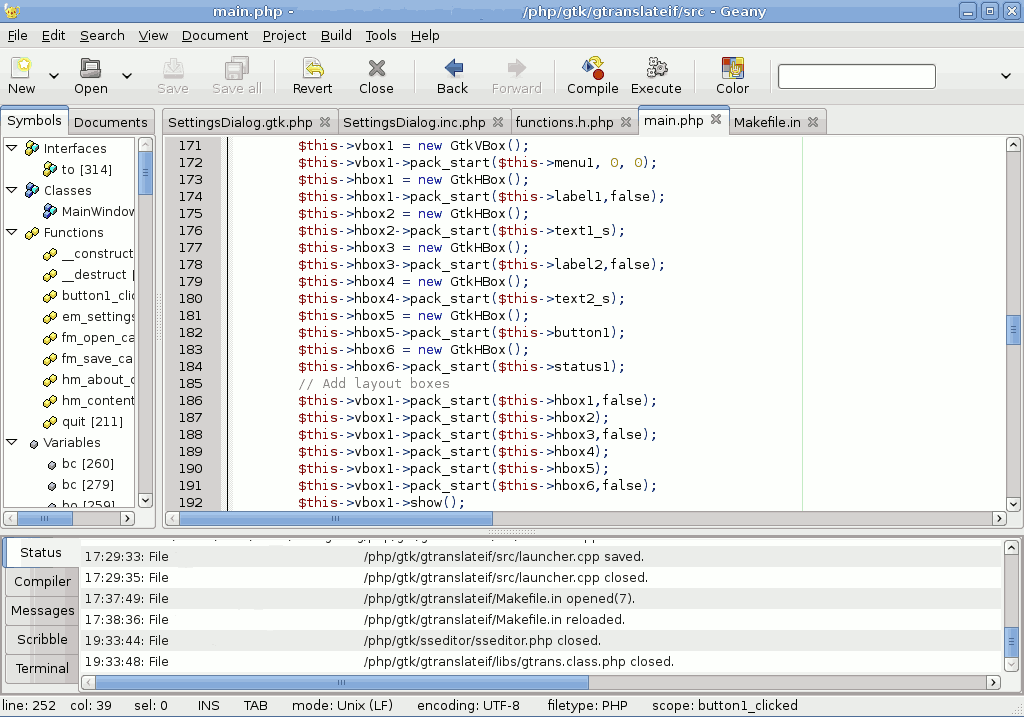
Geany split window copy paste code#
The source code you need for this lab exercise is in the subdirectory lab0-echo of the course materials. The command needs to be run only once, not once for each session. This permanently installs settings under $HOME/.local/share and $HOME/.config/geany, and creates files lab0-echo/lab0.geany, etc. (These project files are machine-specific and not suitable for checking in to version control.) To do this, change to the digisys directory and invoke the shell script setup/genproj: Having cloned the repository, if you want to use Geany then you will need to configure it for editing ARM assembly language, and you will need to generate Geany project files for each lab.

It seems necessary in today's world to believe one or other of the propositions, " Git is better than Mercurial," or " Mercurial is better than Git." If you are already a Git afficionado, then you can use instead the command,


If you want to know more about it, there's a nice tutoral online written by Joel Spolsky. I'm recommending Mercurial for version control because it's easier to learn than Git and just as powerful – I use it for all my own work. We won't be making much use in this course of the power of Mercurial to track changes across multiple versions and multiple files and directories, but in future courses like Compilers you will be required to make modifications, check them in to a version control system, and submit a report on your changes. You can browse the repository contents by opening in a web browser. The repository contains various, independent subdirectories for multiple labs, and the materials for this lab are in the lab0-echo subdirectory. You should begin by making a copy of the Mercurial repository containing the lab materials. If you are using the lab machines, then the toolchain should already be installed for you otherwise, there's a page with installation instructions for Linux systems. Things on the lab machines will be set up so that you just need to double-click on one of these project files in the file manager to open the project in the Geany editor. I've prepared a version of Geany that can understand the syntax of ARM assembly language, and set up project files for each lab that contain the commands needed to build the programs (using make behind the scenes), to upload them to the micro:bit, and if needed to start the GDB debugger. Geany is a simple, open-source editor and IDE that comes with most Linux distributions and is installed by default on the Raspberry Pi. If you don't already have an editor you like, then I suggest using Geany for this course. Other editors can do the same, but if you find yourself reading the error messages from the C compiler and counting lines in the source file, then you are using precious brain cells to do something a machine can do better. I developed the programs using Emacs myself, which can invoke make in an editor window, parse any resulting error messages, and show the lines of source code where the errors occurred. If you already have a preferred editor, especially one that is able to build the program being edited by invoking make, then you can use it to edit the provided programs and make micro:bit programs of your own.
Geany split window copy paste serial#
Our micro:bits will be powered over USB, and will also communicate with the host computer over USB for downloading programs, for sending and receiving charaters on the serial port, and for connection with debugging software running on the host. Some cables (often the ones supplied for charging bike lights, in my experience) have power wires only, and they are useless for our purposes. The cable doesn't need to be very long, but it does need both power and data wires in it. This we ask you to supply, because you probably have several spare ones already – they are the kind often used with mobile phones.

A USB cable, with a full-size 'Type A' plug on one end and a 'Micro B' plug on the other.To carry out the instructions, you will need: Like all the programs we will work with, this one depends on no machine-specific library code, so all the details of how the machine is programmed are explicit. You can get started with programming the micro:bit by building and running a simple program that lets you connect to the micro:bit over a serial interface, then echoes the characters that you type. You can do this from the unix command line, and upload the resulting binary program by copying it with a shell command to a virtual disk drive that represent's the micro:bit's memory. The actions needed to prepare each program are spelled out in a Makefile, which can be interpreted by the unix program make to build the program automatically. The purpose of this lab exercise is to get started with using the micro:bit and the software toolchain that supports building programs for it.


 0 kommentar(er)
0 kommentar(er)
